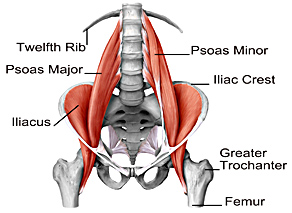Time for another Muscle Monday!
Today’s special guest is the Psoas (pronounced ‘so-as’)
The psoas lies deep beneath your abdominal muscles. It originates from all your lumbar (low back) vertebrae, as well as the the lowest thorasic vertebrae (T12). It then attaches way down at your femur (thigh bone). That means it’s involved in hip flexion (lifting your knee to your chest, as when climbing stairs or walking on an incline) and outwardly rotating your thigh bone.
It’s central location makes it a muscle to pay close attention to. When it’s tight AND weak (which for many of us, it is, due to all the sitting we do), it can contribute to low-back pain, among other issues.
It’s also related to how freely you swing your leg while walking, and the quality of your breath. On an emotional level, the psoas is a key player in our “fight-flight-freeze” response to stress and fear. Think of the fetal position; an instinctual reactive position to fear or stress where the hip is in extreme flexion.
It can be hard to tell what your psoas feels like because it’s difficult to palpate due to it’s depth in the abdominal cavity. That’s why it’s important to get it evaluated by a practitioner before embarking on a stretching or strengthening routine. It is commonly advised to stretch the psoas if it’s tight, but a tight AND weak muscle really doesn’t respond well to stretching.
That said, direct release work w/o stretching can be beneficial (I think Ortho-Bionomy does a great job of this) as can a functional analysis to see which other muscle(s) may be working overtime for the psoas. Once those are released, it is more possible to strengthen the psoas successfully. Check the comments below for an article by David Weinstock of NeuroKinetic Therapy about this very topic.
As always, let me know if you have any questions or psoas insights to share!


One Response
And for those of you reading who are my tonawkedo enthusiasts, every time you lift that leg in the air to kick, the hip flexor initiates the lift. The hip flexors are used and abused constantly, and deserve the time you give them for stretching. Before a workout or competition you might try dynamic stretches for moving and warming up the muscles. For improving general health and flexibility of those muscles over time, try long, slow, myofascial stretching, aimed at release and elongation of the tissues. Stretching too hard and long before a workout or competition can cause injury, so the timing of these kinds of stretches is important.